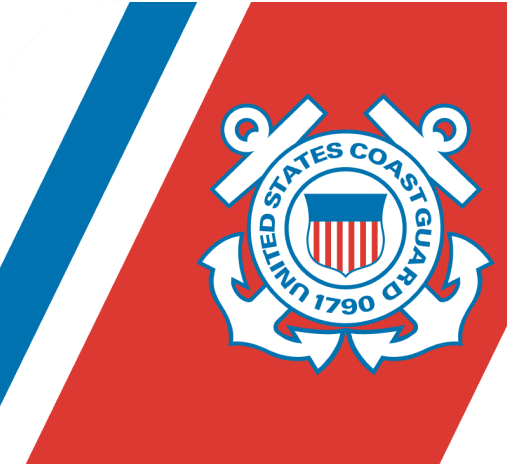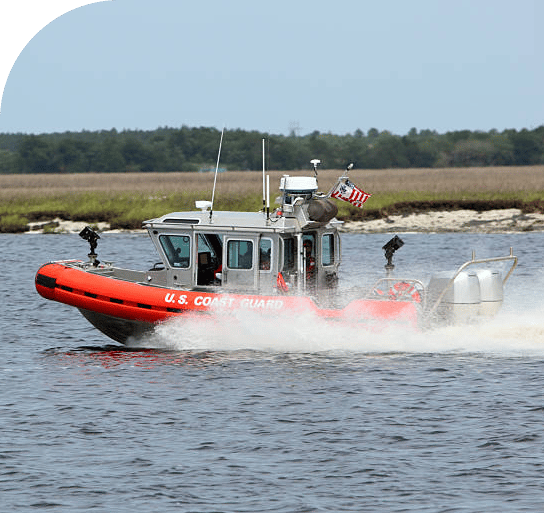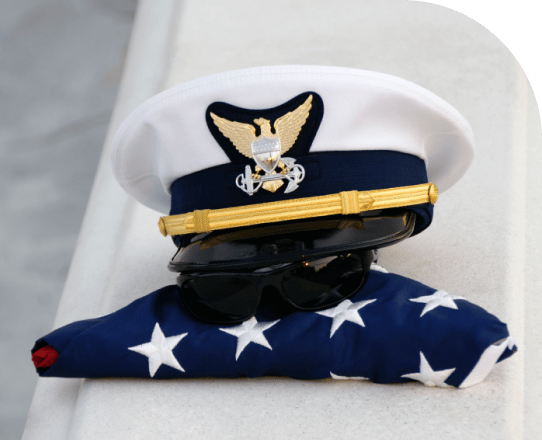Asbestos Exposure in the Coast Guard
The U.S. Armed Forces used asbestos for most of the 20th century. Members of the Coast Guard were mainly exposed to asbestos in their naval vessels, which were built with asbestos-containing materials. As many as 1,800 veterans succumb to asbestos-related illnesses annually. These include asbestosis, lung cancer, and mesothelioma. If you or a loved one has been diagnosed with mesothelioma, contact the Lanier Law Firm today for a free consultation.
Home » National Mesothelioma Law Firm » Veterans » Military Asbestos Exposure » Asbestos Exposure in the Coast Guard

Legally Reviewed By: Darron E. Berquist
Managing Attorney | Asbestos Litigation
- Page Last Updated:
- May 16, 2025
Legally Reviewed By: Darron Berquist
Managing Attorney | Asbestos Litigation
- Page Last Updated:
- May 16, 2025
Sources of U.S. Coast Guard Asbestos Exposure
Are Coast Guard personnel still at risk of asbestos exposure?
The Hidden Dangers of Asbestos
You May Be Entitled to Compensation
Can I sue the USCG for my asbestos exposure?
Who else is liable for Coast Guard asbestos exposure?
How can a mesothelioma attorney help me with my Coast Guard asbestos exposure case?
Why should I choose the asbestos attorneys at The Lanier Law Firm?
Members of the Coast Guard who have been diagnosed with asbestos-related illnesses are entitled to receive VA benefits and may have legal options to recover additional compensation. The experienced mesothelioma attorneys at The Lanier Law Firm can help Coast Guard veterans explore their options.
Sources of U.S. Coast Guard Asbestos Exposure
The U.S. Armed Forces began purchasing asbestos and asbestos-containing products during the 1930s. Coast Guard cutters prior to 1991 are known to contain asbestos. Asbestos use reached its peak during World War II, during which the U.S. Coast Guard (USCG) served vital roles both at home and abroad.
The waterproofing and insulating qualities of asbestos made it ideal for multiple applications in shipbuilding and maintenance, resulting in its use for the following applications:
- Insulation
- Joiner bulkhead systems
- Pipe coverings
- Boilers
- Machinery parts
- Bulkhead panels
- Joiner bulkhead systems in living spaces
- Insulation on both hot water and steam piping
- Tanks
- Machinery parts
- Products used on board ships

Asbestos Exposure at Sea and Abroad
During World War II, the USCG manned more than 350 naval ships, more than 800 cutters and nearly 300 ships for the Army. All branches of the military utilized asbestos in their shipbuilding and maintenance processes, with the highest incidence of asbestos-containing materials in naval vessels.

Asbestos Exposure at Home
The USCG built and repaired ships at the Coast Guard Shipyard at Curtis Bay in Baltimore, Maryland. Established in 1899, it grew from a 36-acre lease by the Revenue Cutter Service to the USCG’s only shipyard. It spans 113 acres today and is known by Coastguardsmen as simply “the yard.”
By World War II, the shipyard had developed fully functional boat, gas engine and machine shops, in addition to a 40-ton marine engine railway and buoys. Substantial amounts of asbestos were used in the construction of ships from 1940 to 1975. During the war period, the Coast Guard built two of the largest-ever cutters: the MENDOTA and the PONTCHARTRAIN.
Civilians Exposed in Coast Guard Shipyards
Civilian employees play a significant role in the USCG’s operations. During World War II, the Coast Guard employed 3,100 civilian workers in the Curtis Bay shipyard. The USCG has continued to employ civilian workers. A study of more than 4,702 civilian workers employed from 1950 through 1964 revealed an increased mortality rate from lung cancer, mesothelioma and other asbestos-related illnesses.
Are Coast Guard personnel still at risk of asbestos exposure?


The Hidden Dangers of Asbestos
Health Effects
You May Be Entitled to Compensation
Coast Guard Veterans
VA Health Care

Preventive care

Diagnostic tests

Medical treatment

Therapy

Rehabilitation

Acute care

Prescription drugs
If you have been diagnosed with mesothelioma or other cancerous conditions related to asbestos exposure, your health care may be free.
Disability Compensation
The VA determines your degree of disability based on medical records or through a VA-administered health examination. Your degree of disability is known as a disability rating and is expressed as a percentage. The higher the percentage, the more significant the disability and the higher your monthly payout.


VA Pension
The VA pension is available to low-income veterans who served during wartime. You are not required to have a service-connected disability to qualify. If you qualify for a pension and disability, you will receive whichever payout results in the higher net payment. You cannot receive both benefits at the same time.
Veterans who receive a pension can also receive Aid and Attendance or Housebound benefits. These are allowances for veterans who need assistance due to disabilities that prevent them from performing daily tasks and self-care.
Family Members
Dependency and Indemnity Compensation (DIC)
Tax-free monthly payments to dependent family members of veterans who passed away due to a service-connected injury or illness
Survivors’ pension benefits
Tax-free monthly payments to low-income surviving dependents of wartime veterans
Medical benefits
- TRICARE for surviving family members of retired Coastguardsmen
- CHAMPVA - a medical cost-sharing program for survivors who do not qualify for TRICARE

Civilians
Civilian employees do not have access to VA benefits, including disability, health care or pension benefits. However, civilian employees, retirees and their surviving family members do have access to similar benefits outside the VA.

Federal Employee Health Benefits (FEHB)
The FEHB program is available to Coast Guard civilian employees, retirees and their families. Surviving family members may also use the program after the death of the employee. Eligible family members include a spouse, children until the age of 26 and disabled children beyond the age of 26 who are unable to provide self-support.
Social Security Disability
Social Security Disability Insurance, or SSDI, provides monthly tax-free payments to qualified individuals with disabilities that are expected to last more than a year or result in death. To qualify, you must have paid enough into the Social Security system through payroll or self-employment taxes, and you must be able to prove your disability to Social Security.


Supplemental Security Income (SSI)
SSI is a monthly tax-free payment from Social Security. If you are over 65 or disabled, and if you have limited income and resources, you may qualify for SSI. You can receive SSI even if you have never paid into the Social Security system. You can apply for SSI or SSDI through the Social Security Administration’s website or in person at your local Social Security office.
Can I sue the USCG for my asbestos exposure?
If you were exposed to asbestos in the course of active duty while serving in the Coast Guard, you cannot sue the military, the VA or the U.S. government, according to the Feres Doctrine.
Supplemental Security Income (SSI)
If you were exposed in the shipyard located in Curtis Bay, any lawsuit would be subject to Maryland’s laws, including the statute of limitations, which is three years after you discover your injury, which is usually the date of your diagnosis. If you were exposed in another jurisdiction, the statute of limitations may vary.
Family members can also file a wrongful death lawsuit against the Coast Guard and sue for burial expenses in addition to the damages mentioned above. The above list is not an exhaustive list of the damages available. Punitive damages are not available in federal tort cases.
- Medical expenses
- Lost wages
- The cost or value of domestic services
- Pain and suffering
- Loss of consortium
- Mental anguish
- Loss of enjoyment of life
Who else is liable for Coast Guard asbestos exposure?
- AO Smith Water Products Company
- Metalclad Insulation Corp.
- Owens-Illinois
- Fibreboard Corporation
- John Crane, Inc.

- Medical treatment costs
- Loss of income
- Emotional distress
- Pain
- Suffering
- Loss of enjoyment of life
- Loss of companionship
- Funeral expenses
- Burial costs
- Punitive damages
Learn More About
Filing a Mesothelioma Lawsuit
- Are you eligible?
- What is the average settlement?
- How long will it take?
Why Should You Trust the Lanier Law Firm to Handle your Mesothelioma Case?
How can a mesothelioma attorney help me with my Coast Guard asbestos exposure case?
Asbestos-related illnesses are devastating financially and emotionally, to both the victim and the family. Monthly maintenance payments from the VA or Social Security fall short of covering the full extent of these damages, adding extra stress to an already overwhelming circumstance.
A qualified asbestos attorney can ensure asbestos victims are properly compensated by filing a lawsuit against the company that sold the asbestos to the military and, in cases of civilian exposure, against the Coast Guard.
One of the early challenges in a Coast Guard asbestos exposure case is identifying all the liable parties. Identifying the Coast Guard’s role is the easy part, but you may not be aware of the company from whom the USCG purchased the asbestos-containing materials.


Why should I choose the asbestos attorneys at The Lanier Law Firm?
Our dedicated lawyers have been handling asbestos cases for more than 32 years, and we know how to find companies that negligently exposed our U.S. Coastguardsmen to asbestos. Our compassionate attorneys spend as much time with new clients as necessary to obtain a detailed service history so we can investigate these sources on your behalf.
Our law firm is nationally recognized as one of the premier asbestos law firms in the nation. Our track record of winning billions on behalf of deserving clients is a reflection of our values, which include serious and sound legal representation. We refer to this as legal care.
If you have been diagnosed with an asbestos-related illness, you may be able to recover substantial compensation, but time is limited. Contact us today to schedule your free consultation.
By submitting this form, you agree to our terms & conditions. Please read the full disclaimer







